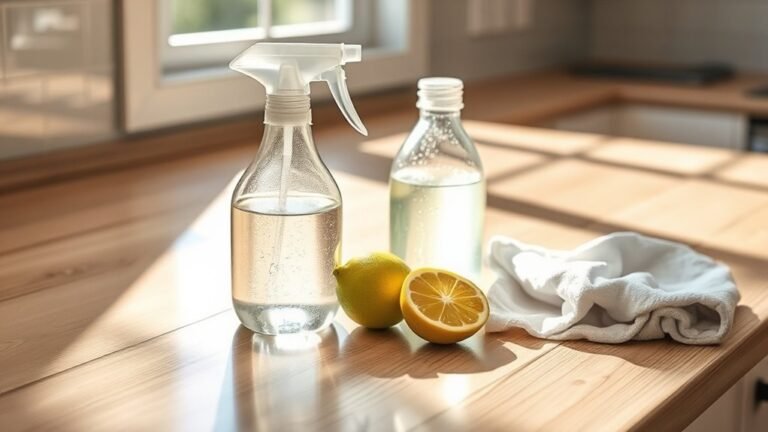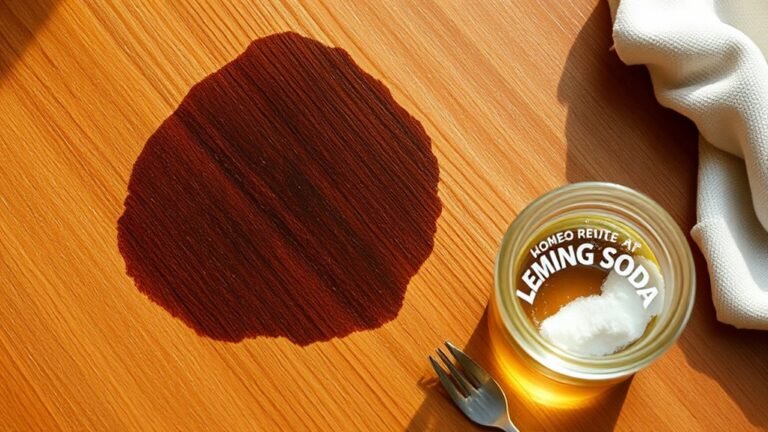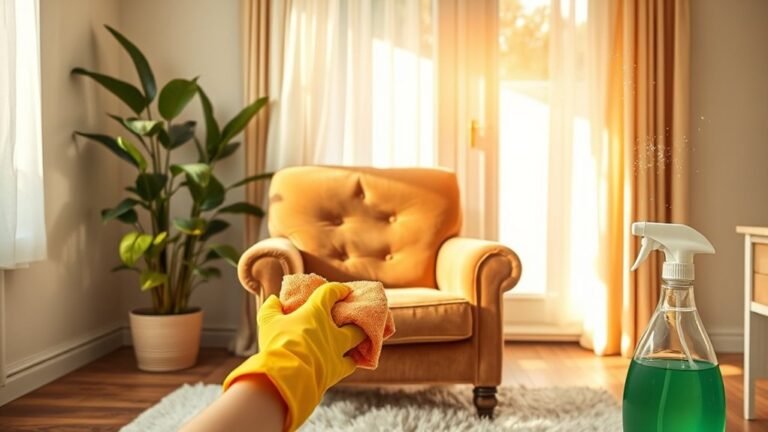Pre-Holiday Cleaning Checklist for Toys
Before the holidays, start by sorting toys into categories and checking them for safety hazards like broken pieces or recalls. Gather gentle cleaning supplies suited for plastic, vinyl, and fabric toys to sanitize everything properly. Organize storage with clear, labeled containers and consider setting up a toy rotation system to keep playtime fresh. Involve your kids in cleaning to teach responsibility. Want to make toy cleanup easier and more fun? Keep going to discover helpful tips and tricks.
Assess and Sort Toys by Type

Before you plunge into cleaning, take a moment to assess and sort your toys by type. Doing this lets you work efficiently, freeing up time for what truly matters—enjoying the holiday spirit without clutter. Start by grouping toys into clear categories: action figures, puzzles, stuffed animals, building blocks, and electronic gadgets. Use simple sorting methods like bins or labeled baskets to keep each toy type separate. This approach not only speeds up cleaning but also helps you identify what needs special care or storage. When you know exactly what you’re dealing with, you gain control and freedom from chaos. Sorting by toy types isn’t just about tidiness; it’s about creating space to breathe and enjoy the season with ease.
Inspect Toys for Damage and Safety Hazards
Once you’ve sorted the toys, take a close look at each one to spot any damage or safety hazards. Check for broken parts, sharp edges, or loose pieces that could hurt little hands. Staying aware of current safety standards helps you decide if a toy still fits your family’s freedom to play worry-free. Don’t forget to review recent toy recalls—these alerts can save you from keeping dangerous items around. If a toy doesn’t meet safety standards or shows signs of wear, it’s best to set it aside or dispose of it responsibly. By carefully inspecting each toy, you guarantee a safe, enjoyable environment where kids can explore and have fun without unnecessary risks holding them back.
Gather Cleaning Supplies for Different Toy Materials

After spotting any damaged or unsafe toys, you’ll want to gather the right cleaning supplies to refresh each item properly. Choosing appropriate cleaning materials is key to effective toy care without causing damage. Here’s a simple list to guide you:
- Mild soap and water – Perfect for most plastic and vinyl toys, gentle yet effective.
- Soft cloths and sponges – Avoid abrasive materials to protect delicate surfaces.
- Disinfectant wipes or sprays – Use alcohol-free options safe for children’s toys.
- Specialty cleaners – Consider fabric-safe sprays for plush toys or wood polish for wooden pieces.
Having these supplies on hand lets you clean confidently, preserving each toy’s quality and making playtime safer and more enjoyable.
Clean Plastic and Vinyl Toys Thoroughly
When you clean plastic and vinyl toys thoroughly, you’ll remove dirt and germs that can build up over time, making them safer for kids to handle. Choosing the right cleaning methods is key for effective toy sanitization without damage. You can liberate yourself from worries about harmful residues by using gentle, natural cleaners or disinfectant wipes designed for children’s items.
| Cleaning Method | Best For |
|---|---|
| Warm Soapy Water | Daily cleaning |
| Disinfectant Wipes | Quick sanitization |
| Vinegar Solution | Non-toxic deep cleaning |
| Rubbing Alcohol | Tough stains and germs |
Stick to these approaches to keep toys fresh and safe, granting freedom from germs and stress this holiday season.
Wash Fabric and Stuffed Toys Properly

A fabric or stuffed toy can quickly become a magnet for dust, allergens, and germs, especially after frequent play. To keep these toys fresh and safe, proper fabric care is essential. Here’s how you can wash them effectively:
- Check the label for washing instructions to avoid damage.
- Pretreat stains using a gentle stain removal solution or mild detergent.
- Use a delicate cycle with cold water in your washing machine, or hand wash for fragile toys.
- Air dry completely, avoiding direct sunlight to preserve colors and shape.
Following these steps lets you maintain your child’s favorite fabric toys, ensuring they stay clean and inviting without compromising their quality or your freedom to choose eco-friendly methods.
Disinfect Electronic and Battery-Operated Toys
Since electronic and battery-operated toys can’t be submerged in water, you’ll need to clean them carefully to avoid damage. Start by removing batteries to practice good battery care and prevent corrosion. Use a soft cloth lightly dampened with a mixture of water and gentle disinfectant for electronic sanitization. Avoid getting moisture into openings or seams. For stubborn spots, a cotton swab dipped in isopropyl alcohol works wonders without harming circuits. After wiping, let the toy air dry completely before reinserting batteries or turning it back on. This method keeps your toys safe, hygienic, and ready for playtime without risking electrical issues. By taking these simple steps, you maintain freedom from worries about germs or battery leaks, ensuring clean fun all holiday season.
Organize Toy Storage Spaces Effectively
Although organizing toy storage might seem overwhelming, having a clear system can save you time and frustration. You’ll feel more freedom when toys have their own places, making cleanup easier and faster. Here’s how to achieve effective organization:
Organizing toys with a clear system saves time and makes cleanup easier, giving you more freedom.
- Sort by category: Group toys like puzzles, art supplies, and action figures together to streamline access.
- Use clear containers: Transparent bins let you see contents quickly, reducing the time spent searching.
- Label everything: Simple labels help kids and adults know exactly where each toy belongs.
- Maximize vertical space: Shelves and hanging organizers free up floor space and keep toys visible.
Donate or Discard Unused or Broken Toys
Take a moment to sort through toys and spot the ones your kids no longer use. Check each toy’s condition to decide if it’s still safe and fun to play with. For those in good shape, consider donating to local charities, while broken or worn-out toys should be responsibly discarded.
Identify Unused Toys
Before you plunge into cleaning, it’s important to identify toys that your kids no longer use or have outgrown. This step frees up space and sets the stage for a focused toy inventory. Here’s how to spot those forgotten favorites:
- Check toy storage areas for items untouched in the last six months.
- Ask your kids which toys they enjoy versus those gathering dust.
- Group toys by type and age appropriateness to see which no longer fit.
- Separate broken or missing-piece toys for possible repair or discard.
Once identified, consider toy donation to give these items a new life, benefiting other children. This process not only declutters but empowers you to create a meaningful, manageable collection that sparks joy and freedom for your family.
Assess Toy Condition
Once you’ve identified which toys are no longer used, it’s important to evaluate their condition carefully. Check each toy for damage like cracks, missing parts, or broken pieces that could pose safety risks. Applying toy longevity tips, such as cleaning and minor repairs, can sometimes extend a toy’s life, but if it’s beyond repair, it’s time to let it go. Using smart toy maintenance strategies regularly prevents wear and keeps toys safe and enjoyable longer. Be honest with yourself—holding onto broken or heavily worn toys only creates clutter and limits your freedom to organize efficiently. Evaluating condition helps you decide which toys deserve a second chance and which should be discarded, making room for a clutter-free, joyful holiday season.
Responsible Donation Options
Three key options await when deciding what to do with unused or broken toys: donate, recycle, or discard. When you want to free up space responsibly, consider these steps:
- Donate to local charities: Find organizations that accept gently used toys, giving them a second life with kids in need.
- Choose eco friendly options: Look for recycling programs that handle plastics and electronics safely.
- Repair or repurpose: Fix broken toys or creatively turn parts into new projects.
- Discard thoughtfully: If a toy’s beyond repair, dispose of it according to your community’s guidelines to minimize environmental impact.
Implement a Toy Rotation System
You’ll find that implementing a toy rotation system keeps playtime fresh and reduces clutter. Start by organizing toys into groups and storing some away, then plan how often you’ll swap them out to maintain interest. This simple routine can make your cleanup easier and keep your kids engaged longer.
Benefits of Toy Rotation
Although it might seem easier to keep all toys out at once, implementing a toy rotation system can greatly enhance your child’s play experience. The toy benefits and rotation advantages make this simple change worthwhile. Here’s why you should consider it:
- Sustains Interest: Rotating toys keeps playtime fresh, preventing boredom and encouraging creativity.
- Promotes Focus: Fewer toys out at once help your child concentrate, boosting quality engagement.
- Simplifies Cleanup: With limited toys in use, tidying up becomes quicker and less stressful.
- Encourages Appreciation: Returning toys to storage and reintroducing them later makes each item feel new and exciting.
How to Organize Toys
When setting up a toy rotation system, the key is to create a routine that’s easy to maintain and fits your space. Start by choosing clear, accessible toy storage containers that make swapping toys simple. Label each container clearly—using pictures or words—so you and your kids can quickly identify what’s inside. This toy labeling helps keep things organized and encourages independence. Next, group toys by type or interest, then store the majority out of sight. Only keep a small selection accessible to avoid overwhelm and clutter. This way, you’re controlling the chaos without restricting play. By maintaining this streamlined system, you’ll free up space and make cleanup effortless, giving you more freedom to enjoy the season without the usual toy mess.
Scheduling Rotation Frequency
Since keeping your toy rotation system effective depends on consistency, setting a clear schedule for rotating toys is essential. A well-planned rotation schedule guarantees toys stay engaging and clutter stays minimal. Here’s how to find the right frequency benefits for your family:
- Assess your child’s interest span—rotate before toys become stale.
- Choose a frequency that fits your routine—weekly, bi-weekly, or monthly.
- Track which toys rotate out and when to prevent overlap or neglect.
- Adjust the schedule based on seasonal changes or holidays to keep things fresh.
Involve Kids in the Toy Cleaning Process
Getting your kids involved in cleaning their toys not only makes the task quicker but also teaches them responsibility and care for their belongings. When you involve children in toy cleaning, you empower them to take ownership, turning a chore into a chance for learning and fun. Keep it simple: hand them a damp cloth for wiping or show them how to sort toys before washing. Let them choose which toys to clean first to spark their interest. This freedom encourages cooperation without pressure. Plus, involving kids means you’re building habits of cleanliness and respect that last beyond the holidays. So, make toy cleaning a shared activity, not a solo job—you’ll save time and give your kids a sense of pride in their space.
Frequently Asked Questions
How Often Should I Perform a Pre-Holiday Toy Cleaning?
You’ll want to weave weekly cleaning with seasonal maintenance to keep toys tidy and tempting. By committing to a consistent cleaning cadence, you create a clutter-free, carefree environment that lets you enjoy your freedom fully. Regular attention prevents buildup and guarantees toys stay safe and sparkling for holiday fun. So, don’t delay—make a habit of thorough tidying to welcome each season with refreshed, ready-to-play treasures.
What Are the Best Natural Cleaning Agents for Toys?
When cleaning toys naturally, you’ll love using vinegar solutions—they’re safe, effective, and super easy to make at home. Just mix equal parts water and white vinegar for a gentle disinfectant. Adding a few drops of essential oils like lavender or tea tree not only boosts cleaning power but leaves a fresh scent too. You’ll feel free knowing your toys are clean without harsh chemicals, perfect for a healthy, carefree environment.
How Can I Make Toy Cleaning Fun for Children?
You can make toy cleaning fun by turning it into a toy scavenger hunt, where kids search for specific toys to clean, turning chores into play. Incorporate cleaning games like timed challenges or “who can clean the most” contests to keep things lively. Let them choose their cleaning tools or sprays, giving them freedom to explore. This way, cleaning feels less like a task and more like an exciting adventure they’re in control of.
Are There Specific Toys That Require Professional Cleaning?
Imagine your specialty toys as delicate treasures, each needing a unique touch. Some, like electronic gadgets or plush collectibles, demand expert cleaning methods to avoid damage. You don’t want to risk their sparkle fading by using harsh soaps or water. So, when you spot toys with intricate parts or special materials, it’s best to let professionals handle them. This way, you keep their magic alive while enjoying your freedom from cleaning worries.
What Storage Conditions Best Preserve Toy Quality After Cleaning?
To keep your toys in top shape after cleaning, you’ll want to focus on temperature control and humidity levels. Avoid extreme heat or cold, as these can damage materials. Keep humidity moderate—too much moisture can cause mold, while too little can make some toys brittle. Store them in a cool, dry place, giving you the freedom to enjoy them whenever you want without worrying about deterioration.






